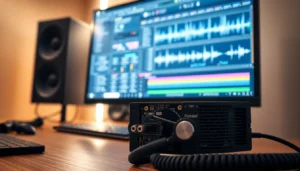In the world of computing, sound card drivers are often the unsung heroes. They’re like the backstage crew at a concert, working tirelessly to ensure everything runs smoothly while the spotlight shines on the main act. Without these drivers, your audio experience could be like a karaoke night gone wrong—awkward and full of static.
Imagine trying to enjoy your favorite tunes or immerse yourself in a gripping game, only to be met with silence or garbled noises. Sound card drivers bridge the gap between your hardware and software, transforming digital signals into the rich sounds that make your heart race. So, let’s dive into the essentials of sound card drivers, why they matter, and how keeping them updated can turn your audio experience from a muffled whisper into a symphony of clarity.
Table of Contents
ToggleOverview of Sound Card Drivers
Sound card drivers serve as essential software that facilitates communication between the computer’s operating system and its sound hardware. These drivers translate data from the CPU into a format that sound cards can process, enabling proper audio playback and recording. Compatibility issues often arise when using outdated or incorrect drivers, resulting in poor sound quality or complete audio failure.
Maintaining up-to-date sound card drivers ensures that the latest features and optimizations are available. Many manufacturers regularly release updates to fix bugs and enhance performance. These updates can improve compatibility with new software and operating systems, which enhances the overall audio experience.
Various types of sound card drivers exist, including generic drivers provided by the operating system and specific drivers from manufacturers like Realtek, Creative, and ASUS. Users often find that dedicated drivers offer superior performance, allowing for advanced features like surround sound and equalizer settings.
Troubleshooting audio problems often requires checking the driver status in the device manager. Users can identify whether the installed drivers are functioning correctly or need updates. Error messages or no sound typically indicate issues with the driver that require immediate attention.
Reliable sources include manufacturer websites and dedicated forums, which frequently provide the latest driver updates and troubleshooting guidelines. Regularly checking these resources helps maintain optimal sound quality and system performance. Adopting this proactive approach to sound card driver management significantly enhances the audio experiences users enjoy during gaming, music playback, and video conferencing.
Importance of Sound Card Drivers

Sound card drivers play a vital role in ensuring optimal audio performance. They facilitate the essential connection between the operating system and sound hardware, enabling users to enjoy high-quality sound across various applications.
Enhancing Audio Quality
Updating sound card drivers significantly improves audio quality. New drivers often address bugs that may hinder sound reproduction. Enhanced drivers also leverage the latest audio technologies, facilitating clearer sound and richer audio experiences. They can optimize settings for diverse audio environments, whether for gaming, music playback, or video conferencing. Users who maintain updated drivers often notice fewer instances of distortion or latency, leading to a more immersive experience.
Ensuring Compatibility
Compatibility issues often arise with outdated or generic sound card drivers. Reliable performance across various software and operating systems depends on manufacturers providing the most current drivers. Specific drivers from manufacturers like Realtek, Creative, and ASUS ensure that hardware functions optimally with the latest operating system updates. Checking the driver status in device manager can reveal compatibility problems that may limit audio functionality. Resolving these issues strengthens the user experience, allowing seamless integration of audio applications and gaming environments.
Types of Sound Card Drivers
Sound card drivers fall into two main categories: generic drivers and specific manufacturer drivers. Each type serves distinct purposes, impacting audio performance and compatibility.
Generic Drivers
Generic drivers often come pre-installed with the operating system. These drivers provide basic support for various sound cards, ensuring essential audio functionality. While they facilitate sound playback and recording, generic drivers may lack specialized features. Users might experience limited audio quality and performance. Compatibility with older hardware or certain applications can also be problematic. For straightforward audio tasks, generic drivers suffice. However, they might not meet the needs of users seeking enhanced sound quality or advanced audio features.
Specific Manufacturer Drivers
Specific manufacturer drivers deliver optimized performance for individual sound cards. Companies like Realtek, Creative, and ASUS create these drivers to unlock the full potential of their hardware. Enhanced audio quality and advanced features such as surround sound and sound enhancements are common with these drivers. Users may find that specific drivers improve compatibility with modern software and operating systems. Updates offer fixes for bugs and enhancements to better the audio experience. For gaming, music playback, and video conferencing, relying on manufacturer drivers significantly elevates sound quality and overall performance.
How to Install Sound Card Drivers
Installing sound card drivers ensures optimal audio performance. Follow the correct methods for your operating system.
Windows Installation Process
To install sound card drivers on Windows, start by identifying the sound card model. Access the manufacturer’s website to find the latest driver specific to that model. Download the driver file, and then locate it in your downloads folder. Double-click the file to initiate the installation wizard. Follow the on-screen instructions to complete the installation. Restart the computer to apply changes. Check the audio settings to confirm the sound card is functioning correctly.
Mac Installation Process
For Mac users, installation of sound card drivers typically occurs automatically. The operating system includes basic drivers for many sound cards. In cases where additional drivers are necessary, visit the manufacturer’s website. Download the required driver file tailored for macOS. Open the downloaded file and follow the installation steps displayed on the screen. Restart the Mac to ensure the installation is effective. After the restart, verify the sound card’s functionality in the system preferences.
Troubleshooting Sound Card Driver Issues
Sound card driver issues can disrupt audio playback, but several troubleshooting steps can resolve these problems effectively.
Common Problems and Solutions
Checking for error messages in the device manager often uncovers common problems like silence or distorted sound. Updating or reinstalling drivers typically resolves these issues. Users might notice sound cuts out during gaming or video playback; this can signal a need for driver attention. Conflicts with other hardware can also occur, leading to audio interruptions. Each situation requires precise diagnostics to determine if the sound card driver needs an update or replacement.
Updating Drivers
Updating sound card drivers ensures the best audio quality and compatibility. Users should first identify their sound card model by checking the device manager. Downloading the latest driver from the manufacturer’s website is essential for resolving bugs. Installation usually involves running a setup wizard and restarting the computer to apply changes. For automatic updates, enabling Windows Update often streamlines the process, ensuring drivers stay current without manual intervention. Regularly checking for updates can optimize sound performance and prevent future issues.
Sound card drivers play an indispensable role in delivering an exceptional audio experience. They bridge the gap between hardware and software ensuring that users enjoy clear and high-quality sound. Regularly updating these drivers is vital for maintaining compatibility and performance across various applications.
By staying informed about the latest driver updates and troubleshooting potential issues users can significantly enhance their audio experiences. Whether it’s for gaming music playback or video conferencing keeping sound card drivers in top shape is crucial for optimal performance. Prioritizing sound card driver management ultimately leads to a richer and more immersive audio journey.



